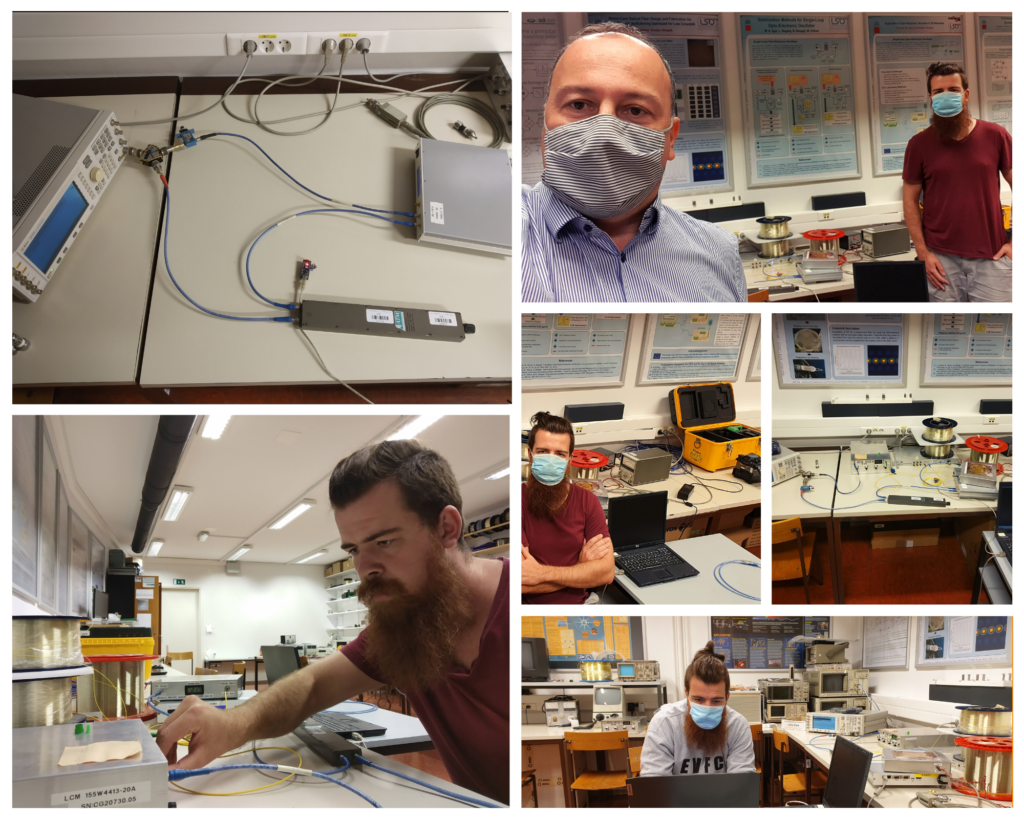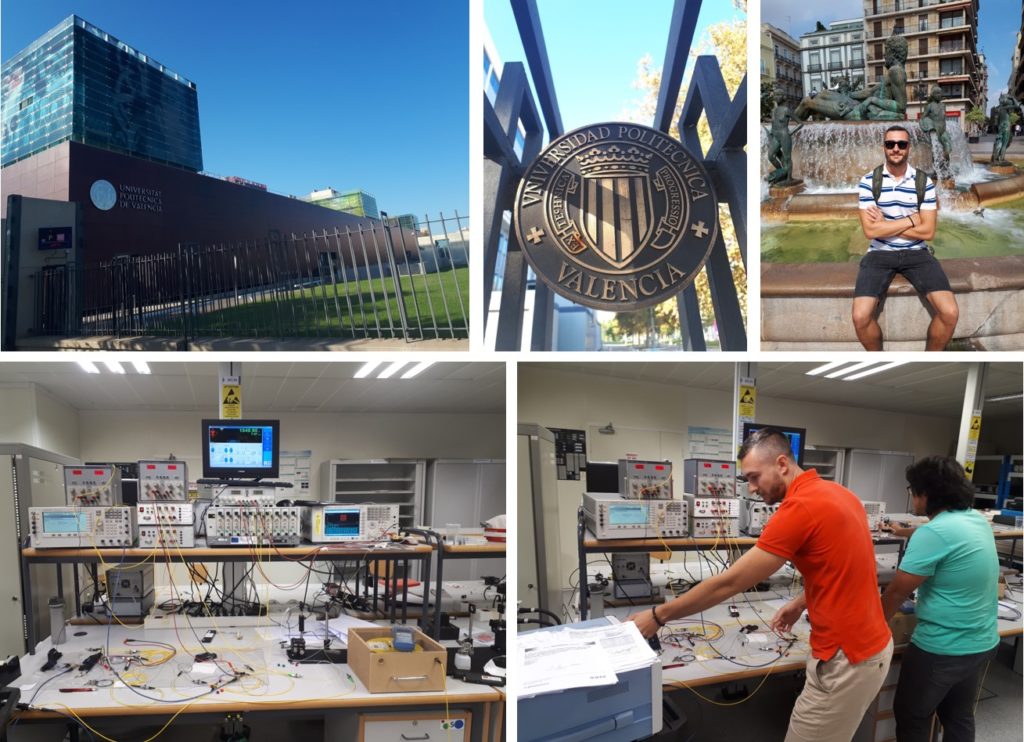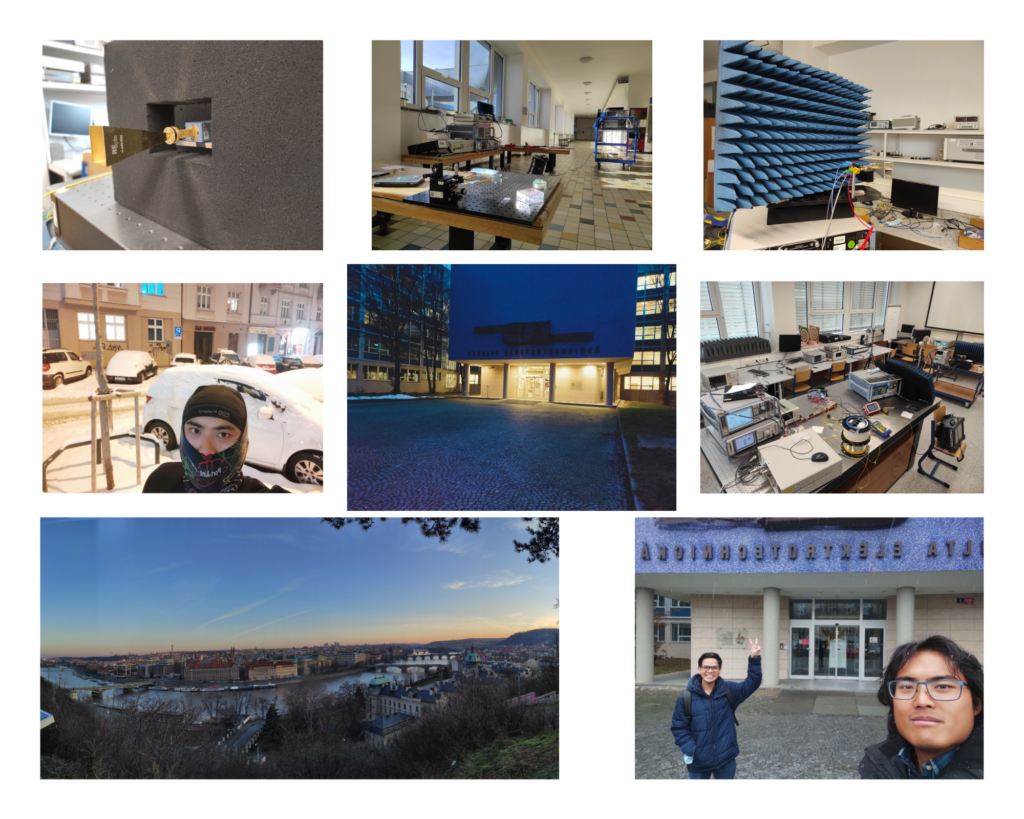Dear EUIMWP participants,
On behalf of our STSM Coordinator, Dr Maurizio Burla, we are pleased to launch the 4th call for STSM in the EUIMWP (CA 16220) COST Action.
In the following guides, you will find the general rules for STSM and indications for preparing applications. All of them can be downloaded from https://www.cost.eu/funding/how-to-get-funding/documents-and-guidelines/:
– COST Vademecum (there’s a new version, May 2020)
– Guidelines for Action management, monitoring and assessment
– Short term scientific mission (STSM) user guide
The selection of STSM applicants will be based on the scientific scope of the application and how it can support the COST Action in achieving its scientific objectives and will take into account the COST Policy and Rules with special attention on Inclusiveness and Excellence.
Please check the list of potential hosts (attached) if you still have not made your plans.
The call will have the following characteristics:
1) Applications can be submitted from now until further notice (when the allocated budget is finished).
2) Applications will be treated on a first-come, first-served basis, after checking the suitability of the applicant and their application.
3) The missions have to finish before March 31st, 2021, one month before the end of the Grant Period (April 30th, 2021). In the case the mission ends during the second half of March, grantees are kindly requested to submit their scientific report in 2 weeks (instead of the usual 30 days). Otherwise, we would have difficulties to process the payment of their grant and our commitment to submit our Financial Report to COST when requested would be endangered.
4) Given the current pandemic, applicants are requested to accept the responsibilities of any potential problems with the travelling restrictions they might face due to the global COVID-19 situation. They will be requested to sign the attached written document (“Acceptance of responsibilities STSM”) to make this commitment official. We strongly recommend, therefore, to purchase a cancellation insurance with your travelling tickets.
5) Please also send 2-6 pictures of you working during your stay, together with a 3-line paragraph describing your mission, so we can publish them in the webpage of the Action (https://euimwp.eu/stsms/). The scientific report will be published in the members’ area.
6) Grantees who have never been reimbursed by the UPV should send Pepa (ghmanager.upv@gmail.com) the form “Dates_address_bank” attached filled in and signed, together with a copy of their passport, in order to be included in the UPV database as a third party for making the payment. In the case the grantee requests the grant in a Spanish bank account, please fill in the form “Datos_Tercero” and provide Spanish DNI or NIE.
The transfer of the grant should be done, preferably, to the grantee’s personal bank account. If this is totally impossible, please let Pepa know and she will inform you about how to proceed.
7) Submitting an application implies the acceptance of all the above-mentioned conditions and characteristics of the call.
Please consider the attached templates. Remember that you will need to upload the application documents at the moment you submit your proposal in the e-cost system, with all the requested signatures on them.
If after reading the guides you still have any questions, please contact Pepa.
Thank you and kind regards,
Maurizio Burla (STSM Coordinator)
José Capmany (Chair and Grant Holder)
Pepa Bayarri (Grant Holder Manager)
Downloadable Files:
STSM Grant Period 1
STSM 1 - Maria Medeiros, Universidade de Coimbra (Portugal) to CNIT-National Inter-University Consortium for Telecommunications, Pisa (Italy).
Grantee: Prof Maria Medeiros, Universidade de Coimbra, Portugal
Host: Antonella Bogonni, CNIT-National Inter-University Consortium for Telecommunications , Pisa (Italy)
Dates: March 23rd to 30th, 2018
STSM Title: Distributed collaborative radar sensing
Workplan summary:
1. Aim&Motivation: CNIT has a demonstration experimental setup of a fully photonic-based RF transceiver both for radar and communication operations with the capability to simultaneously work on different bands and integrating two sensing heads. Prof. Maria Medeiros is invited by Prof. Antonella Bogoni, to perform experimental work on the radar testbed. The objective is to explore the test bed functionalities is order to program future collaborative work on distributed collaborative radar sensing.
2. Proposed contribution to the scientific objectives of the Action: This work is integrated in WG2 activities (Subsystem development through IMWP for wireless communications and radar functionalities).
3. Techniques: Prof. Maria Medeiros will learn the radar testbed general operation particularly the radar received waveform processing and synchronization techniques applied for the join operation of the two sensing heads.
4. Planning: The visit will last 6 days working days. 23rd to 30th March 2018. Day 1: Visit to the labs and demonstration of the general setup. Day 2, 3 Hands on experimental work. Day 4: Work discussion. Day 5: Hands on experimental work on synchronization. Day 6: Follow up discussion and planning of next work.
STSM 2 - Zhongxia Simon He, Chalmers University of Technology, Göteborg (Sweden) to CNIT-National Inter-University Consortium for Telecommunications, Pisa (Italy).
Grantee: Prof Zhongxia Simon He, Chalmers University of Technology, Göteborg (Sweden)
Host: Dr. Antonella Bogoni, TeCIP-Institute of TEchnologies for Communication, Information and Perception- Scuola superiore Sant'Anna Photonic Networks & Technologies National Laboratory - CNIT, Pisa (Italy) Dates: March 30th to April 4th, 2018
STSM Title: Visit to CNIT for radar testbed experiments
Workplan summary:
1. Motivation: CNIT has a unique fiberoptic based radar system operates at S band with 20 MHz bandwidth. Dr. He is invited by Prof. Bogoni to perform experiment on that radar testbed, so the result can be used to compare with full electrical radar implementataion. Dr. He is organizing a short course at the flagship conference IEEE microwave symposium 2018. The course topic is "Using active fiber optic for distributed antenna system (DAS) system in 5G mimo system and automobile radar system". Prof. Bogoni would give a talk in my course. This course covers both telecom (5G) and automotive applications which is in line with this COST action. Dr. He and Prof. Bogoni would take this chance to present the result of the experiment.
2. Proposed contribution: A short course/ workshop at flagship microwave conference targeting both 5G and automotive application. PIC, as well as this EU COST action, would be promoted to both academia and industry. Possible publication from the test result from the experiment during this STSM
3. Technique: Dr. He will perform experiment on CNIT radar testbed, using novel radar waveform to improve radar resolution under limited bandwidth. This trip also including general visit to CNIT and detailed course planning. This would open future technical cooperation as well as student exchange in the future.
4. Planning: The visit lasting 6 days: 1 day general Visit CNIT, including lab tour, 3 days experiment with radar testbed 2 days summerize the result and follow up discussion.
STSM Grant Period 2
STSM 3 - Catia Pinho, from Universidade de Aveiro (Portugal) to Universitat Politècnica de Valéncia (Spain).
Catia Pinho, a PhD student from the Instituto de Telecomunicações, Universidade de Aveiro (Portugal) has spent 17 days in the Universitat Politècnica de València (Spain), working under the supervision of Prof. Pascual Muñoz in Photonic Integrated Circuits, Photonics Research Labs. During her STSM she worked on the design of photonic integrated circuits (PIC) for silicon nitride technologies and promoted current/future collaboration(s) between the two research groups.
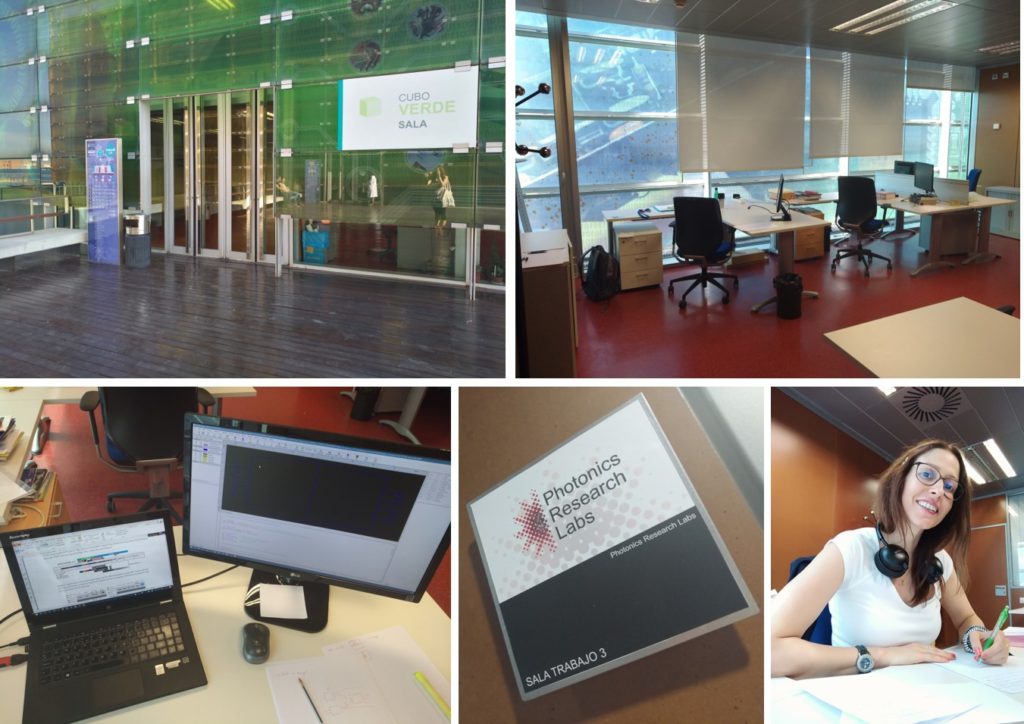
STSM 4 - Matthias Steeg, from University of Duisburg-Essen (UDE, Germany) to University of Cyprus (Cyprus).
Matthias Steeg, a PhD student from the University of Duisburg-Essen (UDE, Germany) has recently visited the lab of Stavros Iezekiel, in the University of Cyprus ( UCY, Latsia, Cyprus) during 29 days, with the aim of developing and fabricating a 5G 26 GHz photonic beam steering transmitter. Therefore, PCB leaky-wave antennas, produced at UCY during the STSM, are integrated with microwave photodiodes from UDE to enable changing the beam direction of the transmitter remotely through photonic techniques employing tunable lasers.
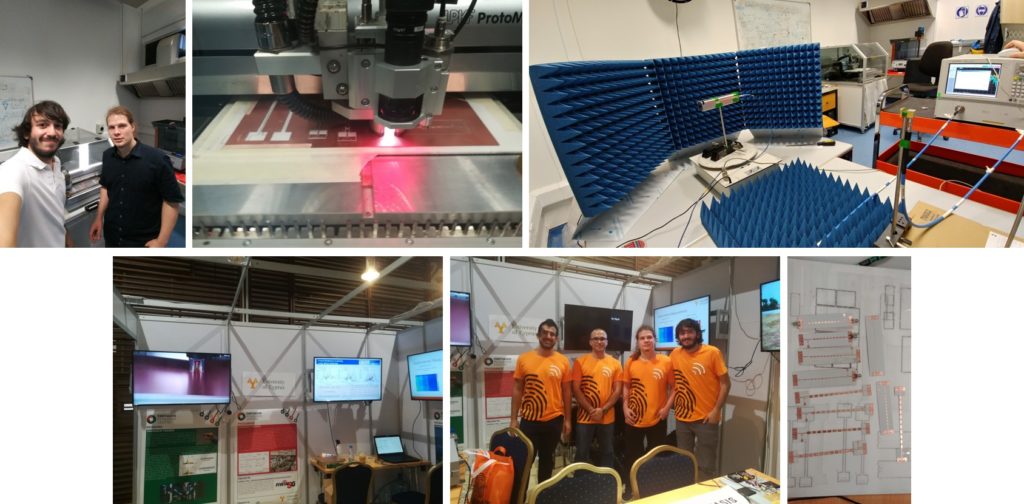
STSM 6 - Maina Moutaly, a PhD student from ESYCOM (Le Cnam, University of Paris-Est, ESIEE-Paris, France)
Maina Moutaly, a PhD student from ESYCOM (Le Cnam, University of Paris-Est, ESIEE-Paris, France) has recently visited the team of Nathan Gomes, Communications Research Group in the School of Engineering and Digital Arts, at the University of Kent (Canterbury UK) during 25 days. The purpose was to perform an experimental performance evaluation of analogue radio-over-fiber for 5G waveform transport. The results obtained showed a promisingly high performance fronthaul using phase modulation with interferometric detection for the uplink and intensity modulation with direct detection for the downlink. Similar or, in some cases, even better performance was demonstrated for the phase modulated link compared to the intensity modulated one leading to a possible energy efficiency optimisation at the remote unit as the optical phase modulator does not require a bias supply.
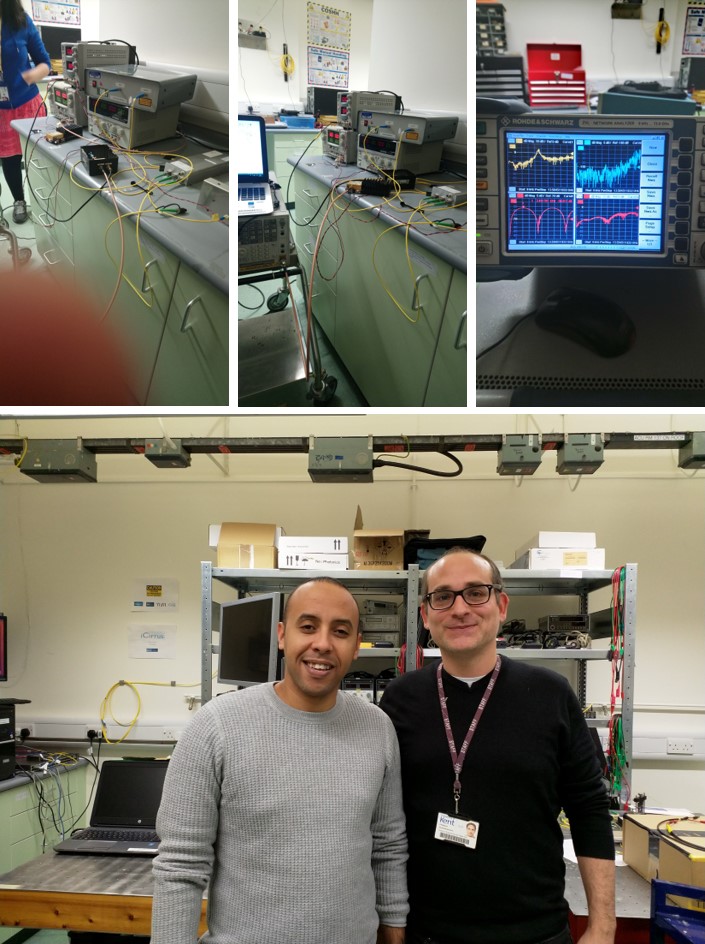
STSM 7 - Dr Salim Faci from Le Conservatoire des Arts et Métiers, Paris (France) to the University of Kent (UK).
Dr. Salim FACI, an associate professor from Le Conservatoire National des Arts et Métiers, Paris (France), visited Prof. Nathan Gomes and his team in the University of Kent, Canterbury (UK) from 12th to 16th November 2018 with the purpose of evaluation of radio over fiber performances for 5G fronthaul applications based on phase modulation and coherent detection. During this STSM, silicone photonic integrated circuits were defined as a potential solution for such analogue photonic systems. Future collaboration between the two intuitions was engaged on this way.
STSM 8 - Rui Min, a pre doctor researcher from ITEAM, Universitat Politècnica de València (Spain)
Rui Min, a pre doctor researcher from ITEAM, Universitat Politècnica de València (Spain), made a stay in the Chalmers University of Technology (Sweden), under the supervision of Prof. Victor Torres Company, aiming to investigate the thermo-optic control of silicon rich silicon nitride high Q microresonators and microresonator frequency comb generation. During his mission, he worked on measure the thermo optics speed of silicon rich silicon nitride microresonators.
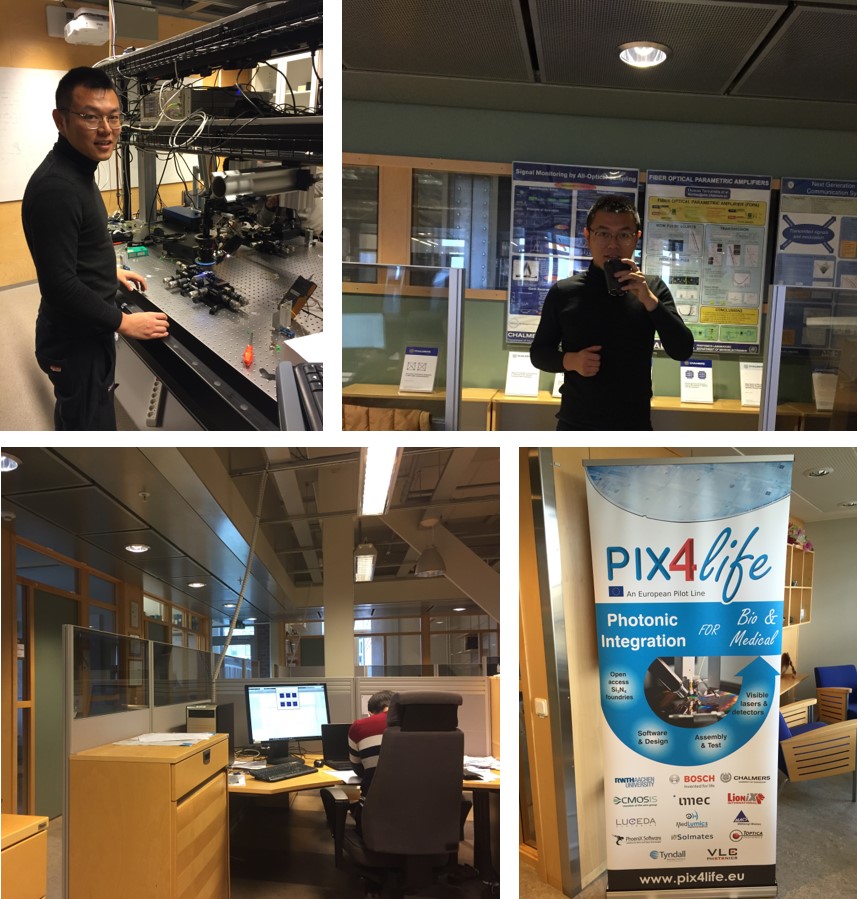
STSM 9 - Cátia Pinho, from Universidade de Aveiro (Portugal) to Universitat Politècnica de València (Spain).
Catia Pinho, a Ph.D. candidate from the Instituto de Telecomunicações, Universidade de Aveiro (Portugal) has spent two weeks in the Universitat Politècnica de València (Spain), working under the supervision of Prof. Pascual Muñoz in Photonic Integrated Circuits, Photonics Research Labs. During her STSM she worked on the design structure optimization of photonic integrated circuits (PIC) for silicon nitride technologies (to continue/conclude the work started in the first STSM). Furthermore, current/future collaboration(s) between the two research groups were also strengthened.
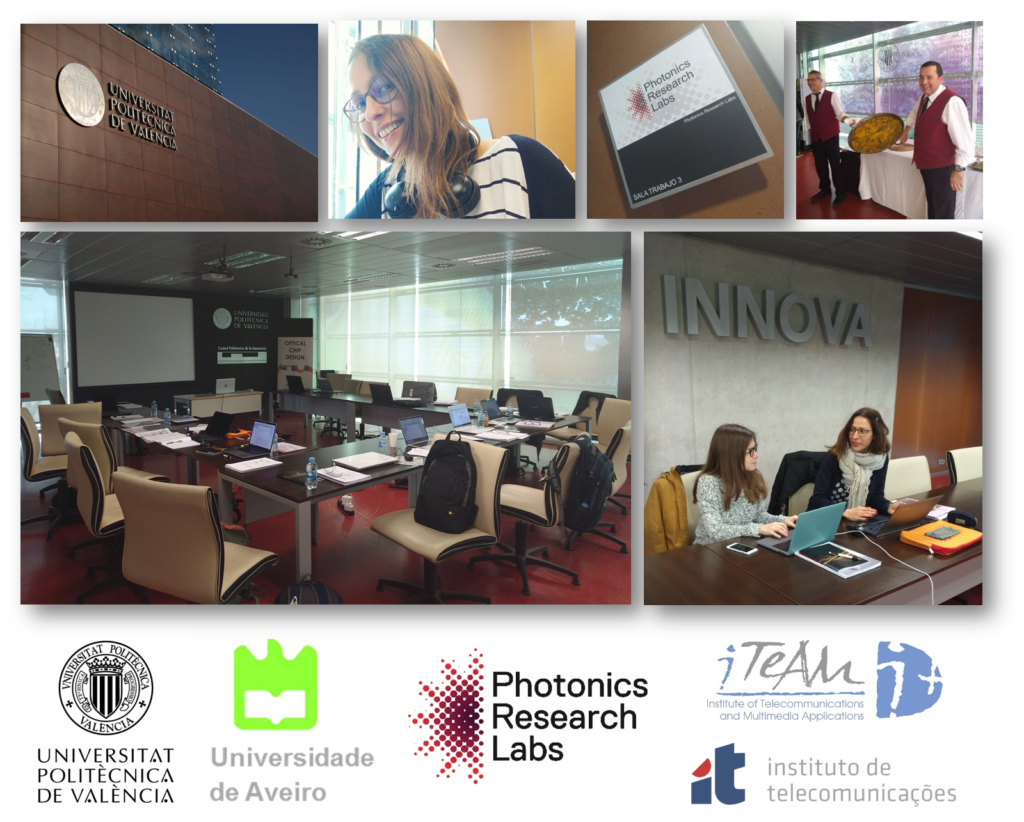
STSM 10: Kyriakos Neophytou, University of Cyprus (Cyprus) to University of Duisburg-Essen (Germany).
Kyriakos Neophytou, a Ph.D. student from the University of Cyprus (Cyprus) has recently visited the Institute of Optoelectronics at the University of Duisburg-Essen (Germany) during 48 days, under the supervision of Prof. Andreas Stöhr. The purpose of the STSM was to investigate the implementation of backscattering Mobile Terminals (MTs) to an all-photonic FMCW system in order to simultaneously identify and locate the MTs. The experiments were successful and the researchers were able to simultaneously localize and identify the MTs with minimal signal processing power.
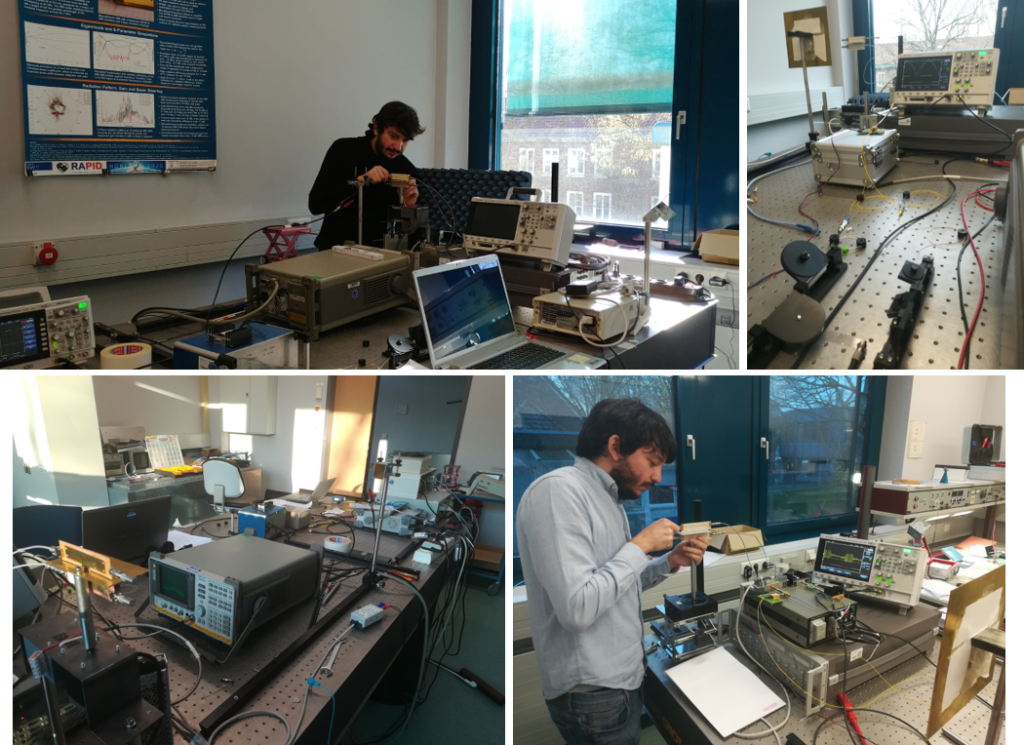
STSM 11 - Nada Badraoui, from Budapest University (Hungary) to University of Duisburg-Essen (Germany).
The 5G mobile network deployment goal is to provide 1-10 Gb/s wireless signal for the end user. For that purpose, polarization multiplexing (POL-MUX) can be utilized to double the bandwidth efficiency. At these bit rates, the polarization mode dispersion (PMD) becomes very problematic as a bit rate limiting factor. It influences the polarization cross talk and polarization extinction ratio (PER). We propose the application of single side-band Pol-Mux techniques for radio over fibre system achieving this way increased capacity. The performance of the orthogonal coherent polarization multiplexed (Pol-Mux) in a radio over fibre system for multi-user MIMO using linear polarized antennas technique is improved by using polarization beam splitter/combiner and polarization controller with different polarization phase shift, different fibres length, and different bit rate.''

STSM Grant Period 3
STSM 13: Mushin Ali, from Universidad Carlos III de Madrid (Spain) to Fraunhofer Heinrich Hertz Institute (HHI) in Berlin (Germany)
Muhsin Ali, a PhD student at Universidad Carlos III de Madrid, Spain visited Fraunhofer Heinrich Hertz Institute (HHI) in Berlin, Germany for a period of two months. Under the supervision of Dr. Björn Globisch, he worked with two different research groups of THz Sensors and Systems and Polymer PIC. The aim of the STSM was to design and develop antenna-integrated mm-Wave and THz photonic emitters based on HHI’s PIN-photodiodes. Such devices find applications in multi-Gbps microwave photonic wireless communications systems. Moreover, THz broadband antenna arrays were designed, along with fabrication mask, on HHI’s PolyBoard material, to be used in photonics-enabled phased array emitters for 2D beamsteering. The primary outcome of this research stay is development of first ever WR-03 (J-band) integrated PIN-PD emitter module.
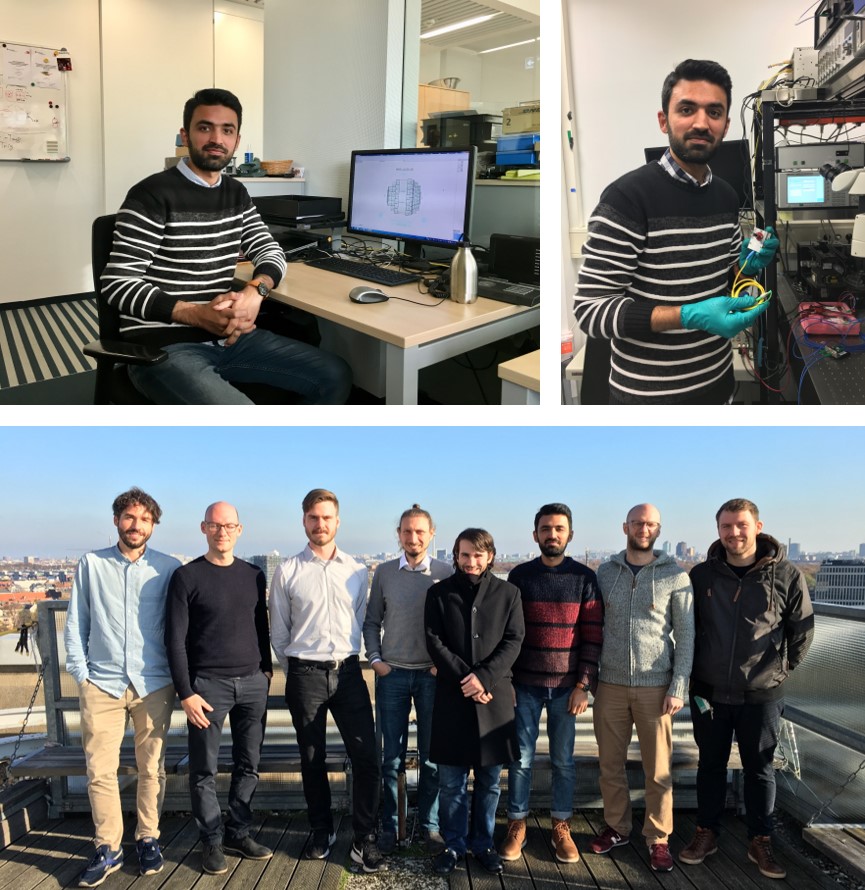
STSM 14: Andrej Lavric, from the Faculty of Electrical Engineering in Ljubljana (Slovenia) to Photonic Networks & Technologies National Laboratory of CNIT in Pisa (Italy)
Andrej Lavric, a PhD student from the Faculty of Electrical Engineering in Ljubljana (Slovenia) visited Photonic Networks & Technologies National Laboratory of CNIT in Pisa (Italy). During the 10 days of visit he performed a characterization of sensitivity, bandwidth, and linearity of house-packaged photodiodes. Photodiodes were successfully used in microwave photonics experiments ranging from optoelectronic oscillator, microwave photonics assisted measurement of phase noise and possible 5G radio access network. Performance of characterized photodiodes showed comparable to commercial solution of laboratory diodes thus making it an attractive cost effective solution for future microwave photonics experiments. Reference to the characterized diodes:
A. Lavrič and B. Batagelj, "An Affordable Laboratory Photodiode up to
11.5 GHz for Microwave Photonics Experiments," 2019 International
Workshop on Fiber Optics in Access Networks (FOAN), Sarajevo, Bosnia and Herzegovina, 2019, pp. 47-50. doi: 10.1109/FOAN.2019.8933688
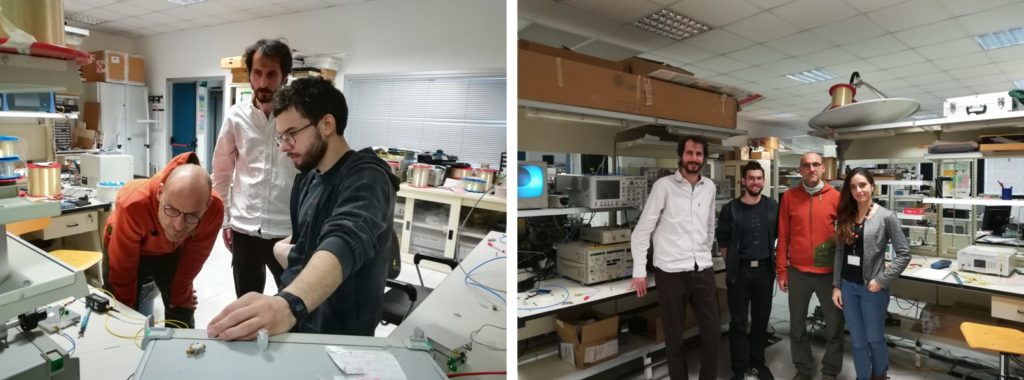
STSM 15: Luis Vallejo, from Instituto de Telecomunicaciones y Aplicaciones Multimedia, Universitat Politecnica de València (Spain), to Czech Technical University in Prague (Czech Republic).
Luis Vallejo, a PhD student from Instituto de Telecomunicaciones y Aplicaciones Multimedia, Universitat Politecnica de Valencia (Spain), made a stay in Czech Technical University in Prague (Czech Republic), under the supervision of Stanislav Zvanovec, aiming to advance method in microwave photonics, during 35 days. During his STSM he worked on photonically millimetre signal generation, signal transmission over hybrid fiber/free-space-optics (FSO) links considered as a promising solution in the cloud radio access network (C-RAN) in 5G, and evaluation of the impact of turbulences on the FSO link. Furthermore, current and future collaboration between the two research groups have been consolidated.

STSM Grant Period 4
STSM 16: Dong-Nhat Nguyen, from Czech Technical University in Prague (Czech Republic) to Universitat Politècnica de València (Spain)
Dong-Nhat Nguyen, a postdoc from Czech Technical University in Prague, Czech Republic made a 1-month stay at Instituto de Telecomunicaciones y Aplicaciones Multimedia, Universitat Politècnica de Valencia, Spain under the supervision of Prof. Beatriz Ortega to carry out the research on bidirectional microwave photonic links for 5G. During his STSM, he worked on both experiments and simulation of the 5G NR and multiband signals transmission over seamless full-duplex radio-over-fiber and free-space optics systems at sub-6 GHz and mmW frequencies using a low-cost DML. Furthermore, current and future collaboration between the two research groups have been further consolidated.
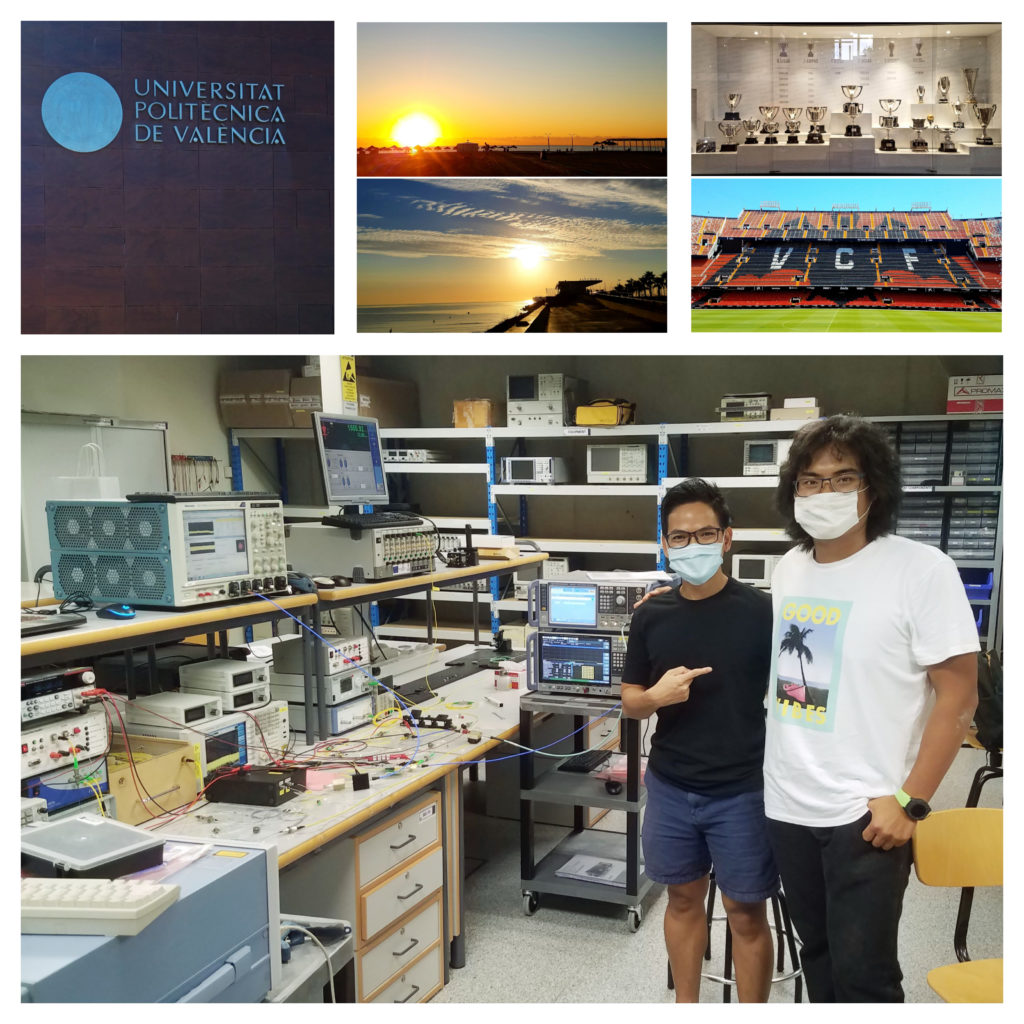
STSM 18. Ágoston Schranz, from Budapest University of Technology and Economics, Hungary to University of Ljubljana (Slovenia)
Ágoston Schranz, who works as an assistant research fellow at the Department of Networked Systems and Services, Budapest University of Technology and Economics (Hungary), spent 22 days at the Faculty of Electrical Engineering, University of Ljubljana (Slovenia), under the supervision of Dr. Boštjan Batagelj. During this STSM, he measured the effect of ambient parameters, mainly temperature, on the phase drift of a periodic microwave signal modulated onto an optical carrier. As the precision of synchronization between remote locations is highly important in case of many applications, it is important to understand the origin of phase changes, as well as the expected amount of phase drift under given conditions. Several long-term measurements were conducted, using different optical link lengths between 0 and 17.5 km. The results showed that the phase drift is mainly due to temperature changes. The quantitative values are in good agreement with those predicted by theory.
